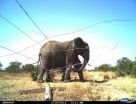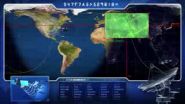(Press-News.org) NEW YORK (Embargoed – Not for release until 14:00 EST 3 April 2014) Wildlife fences are constructed for a variety of reasons including to prevent the spread of diseases, protect wildlife from poachers, and to help manage small populations of threatened species. Human–wildlife conflict is another common reason for building fences: Wildlife can damage valuable livestock, crops, or infrastructure, some species carry diseases of agricultural concern, and a few threaten human lives. At the same time, people kill wild animals for food, trade, or to defend lives or property, and human activities degrade wildlife habitat. Separating people and wildlife by fencing can appear to be a mutually beneficial way to avoid such detrimental effects. But in a paper in the journal Science, published today, April 4th, 2014, WCS and ZSL scientists review the 'pros and cons' of large scale fencing and argue that fencing should often be a last resort.
Although fencing can have conservation benefits, it also has costs. When areas of contiguous wildlife habitat are converted into islands, the resulting small and isolated populations are prone to extinction, and the resulting loss of predators and other larger-bodied species can affect interactions between species in ways that cause further local extinctions, a process which has been termed "ecological meltdown".
"In some parts of the world, fencing is part of the culture of wildlife conservation – it's assumed that all wildlife areas have to be fenced. But fencing profoundly alters ecosystems, and can cause some species to disappear. We're asking that conservationists as well as other sectoral interests carefully weigh up the biodiversity costs and benefits of new and existing fences," said ZSL's Rosie Woodroffe, lead author of the study.
In addition to their ecosystem-wide impact, fences do not always achieve their specific aims. Construction of fences to reduce human–wildlife conflict has been successful in some places but the challenges of appropriate fence design, location, construction, and maintenance mean that fences often fail to deliver the anticipated benefits. Ironically, in some places, fences also provide poachers with a ready supply of wire for making snares.
Co-author Simon Hedges of WCS said: "A variety of alternative approaches – including better animal husbandry, community-based crop-guarding, insurance schemes, and wildlife-sensitive land-use planning – can be used to mitigate conflicts between people and wildlife without the need for fencing. WCS projects working with local people and government agencies have shown that human–elephant conflict can be dramatically reduced without using fences in countries as different as Indonesia and Tanzania."
Co-author Sarah Durant of ZSL's said, "An increased awareness of the damage caused by fencing is leading to movements to remove fences instead of building more. Increasingly, fencing is seen as backwards step in conservation."
The desire to separate livestock from wildlife in order to create zones free from diseases such as foot and mouth has resulted in extensive fencing systems, particularly in southern Africa. Some of these fences have had devastating environmental effects. Fortunately, it is increasingly recognized that a combination of improved testing, vaccination, and standardized approaches to meat preparation can prevent spread of diseases without the need to separate cattle from wildlife by fencing.
The authors conclude that as climate change increases the importance of facilitating wildlife mobility and maintaining landscape connectivity, fence removal may become an important form of climate change preparedness, and so fencing of wildlife should be avoided whenever possible.
INFORMATION:
Wildlife Conservation Society (WCS)
MISSION: WCS saves wildlife and wild places worldwide through science, conservation action, education, and inspiring people to value nature. VISION: WCS envisions a world where wildlife thrives in healthy lands and seas, valued by societies that embrace and benefit from the diversity and integrity of life on earth. To achieve our mission, WCS, based at the Bronx Zoo, harnesses the power of its Global Conservation Program in more than 60 nations and in all the world's oceans and its five wildlife parks in New York City, visited by 4 million people annually. WCS combines its expertise in the field, zoos, and aquarium to achieve its conservation mission. Visit: http://www.wcs.org; http://www.facebook.com/TheWCS; http://www.youtube.com/user/WCSMedia Follow: @thewcs.
Fences cause 'ecological meltdown'
2014-04-03
ELSE PRESS RELEASES FROM THIS DATE:
Quantum photon properties revealed in another particle -- the plasmon
2014-04-03
For years, researchers have been interested in developing quantum computers—the theoretical next generation of technology that will outperform conventional computers. Instead of holding data in bits, the digital units used by computers today, quantum computers store information in units called "qubits." One approach for computing with qubits relies on the creation of two single photons that interfere with one another in a device called a waveguide. Results from a recent applied science study at Caltech support the idea that waveguides coupled with another quantum particle—the ...
NIST launches a new US time standard: NIST-F2 atomic clock
2014-04-03
The U.S. Department of Commerce's National Institute of Standards and Technology (NIST) has officially launched a new atomic clock, called NIST-F2, to serve as a new U.S. civilian time and frequency standard, along with the current NIST-F1 standard.
NIST-F2 would neither gain nor lose one second in about 300 million years, making it about three times as accurate as NIST-F1, which has served as the standard since 1999. Both clocks use a "fountain" of cesium atoms to determine the exact length of a second.
NIST scientists recently reported the first official performance ...
Taming a poison: Saving plants from cyanide with carbon dioxide
2014-04-03
The scientific world is one step closer to understanding how nature uses carbon-capture to tame poisons, thanks to a recent discovery of cyanoformate by researchers at Saint Mary's University (Halifax, Canada) and the University of Jyväskylä (Finland). This simple ion — which is formed when cyanide bonds to carbon dioxide — is a by-product of the fruit-ripening process that has evaded detection for decades.
Chemists have long understood the roles presence of cyanide (CN−) and carbon dioxide (CO2) in fruit ripening, but have always observed them independently. This ...
Hot mantle drives elevation, volcanism along mid-ocean ridges
2014-04-03
PROVIDENCE, R.I. [Brown University] — Scientists have shown that temperature differences deep within Earth's mantle control the elevation and volcanic activity along mid-ocean ridges, the colossal mountain ranges that line the ocean floor. The findings, published April 4 in the journal Science, shed new light on how temperature in the depths of the mantle influences the contours of the Earth's crust.
Mid-ocean ridges form at the boundaries between tectonic plates, circling the globe like seams on a baseball. As the plates move apart, magma from deep within the Earth rises ...
HIV vaccine research must consider various immune responses
2014-04-03
WHAT:Last year, the National Institute of Allergy and Infectious Diseases (NIAID), part of the National Institutes of Health, held a scientific meeting to examine why certain investigational HIV vaccines may have increased susceptibility to HIV infection. In a new perspectives article appearing in the journal Science, HIV research leaders from NIAID (Anthony S. Fauci, M.D., and Carl W. Dieffenbach, Ph.D.) and its grantees at Emory University (Eric Hunter, Ph.D.) and the University of California, San Francisco (Susan Buchbinder, M.D.), summarize the findings and considerations ...
Moving the fence posts
2014-04-03
The use of fenced areas to protect threatened species in the wild should be a last resort, argue scientists from the Zoological Society of London (ZSL) and the Wildlife Conservation Society (WCS).
In an article published in the journal Science, the authors state that there is a need to review the use of fencing as the conservation community develops a clearer understanding of the ecological changes caused when an area is fenced.
Fencing can have a disruptive impact on predator-prey dynamics, with species such as the African wild dog learning to chase prey into fences. ...
Researchers design trees that make it easier to produce paper
2014-04-03
Researchers have genetically engineered trees that will be easier to break down to produce paper and biofuel, a breakthrough that will mean using fewer chemicals, less energy and creating fewer environmental pollutants.
"One of the largest impediments for the pulp and paper industry as well as the emerging biofuel industry is a polymer found in wood known as lignin," says Shawn Mansfield, a professor of Wood Science at the University of British Columbia.
Lignin makes up a substantial portion of the cell wall of most plants and is a processing impediment for pulp, ...
Cassini reports sub-surface ocean on Enceladus
2014-04-03
Enceladus—one of Saturn's smaller satellites—has joined the ranks of Titan and Europa as a moon that appears to have liquid water splashing around inside of it, researchers say. New gravity data from the Cassini spacecraft, which has been exploring the planet's moons for 10 years, reveal that Enceladus harbors an ocean of water beneath 18 to 24 miles (30 to 40 kilometers) of ice at its surface.
A team of Italian and American scientists led by Luciano Iess at Sapienza Università di Roma in Rome, Italy investigated the moon's gravity field and the notable asymmetry it ...
Gravity measurements confirm subsurface ocean on Enceladus
2014-04-03
In 2005, NASA's Cassini spacecraft sent pictures back to Earth depicting an icy Saturnian moon spewing water vapor and ice from fractures, known as "tiger stripes," in its frozen surface. It was big news that tiny Enceladus—a mere 500 kilometers in diameter—was such an active place. Since then, scientists have hypothesized that a large reservoir of water lies beneath that icy surface, possibly fueling the plumes. Now, using gravity measurements collected by Cassini, scientists have confirmed that Enceladus does in fact harbor a large subsurface ocean near its south pole, ...
'Unzipping' poplars' biofuel potential
2014-04-03
EAST LANSING, Mich. — What began 20 years ago as an innovation to improve paper industry processes and dairy forage digestibility may now open the door to a much more energy- and cost-efficient way to convert biomass into fuel.
The research, which appears in the current issue of Science, focuses on enhancing poplar trees so they can break down easier and thus improving their viability as a biofuel. The long-term efforts and teamwork involved to find this solution can be described as a rare, top-down approach to engineering plants for digestibility, said Curtis Wilkerson, ...



